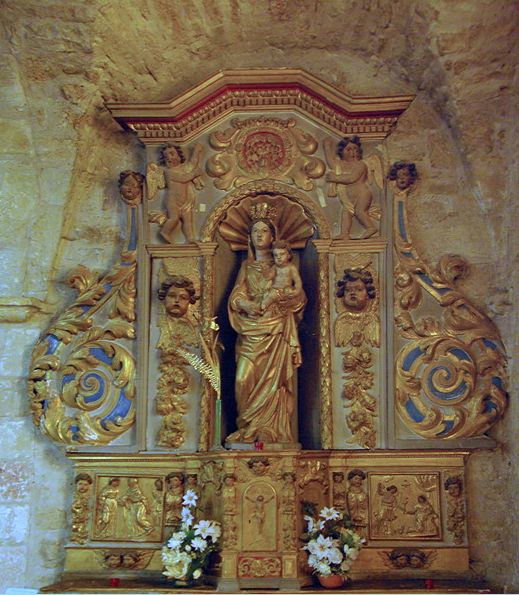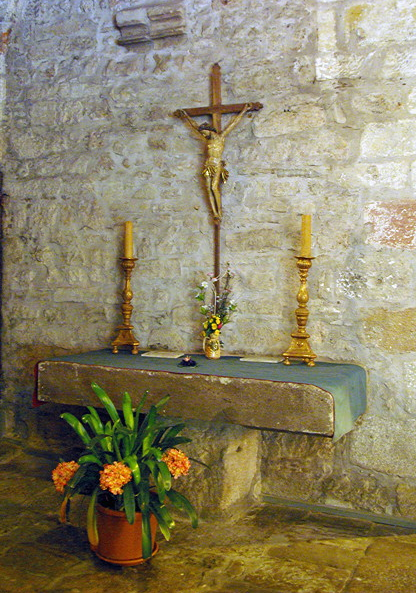Eleanor
1000+ Posts
TO THE WEST OF CASSANIOUZE - CAPDENAC-LE-HAUT
Capdenac le Haut is a tourist honey pot village, about 4km south east of Figeac and is again, listed as one of the most beautiful villages in France. Tourist Information in Figeac have a leaflet in French with information and a guided walk around the settlement.

It is built in a commanding position above a loop in the River Lot. There is the compulsory, and very large, visitors car park outside village. We visited on a Monday when everything was shut (bakers, restaurants, tourist information and museum) but it did have the advantage of there not being many people around.

There has been a settlement here since neolithic times. The peninsula is surrounded by steep cliffs and there are spectacular views from the top.

The town had been a Celtic hill fort, Roman settlement and was an walled town in medieval times with a C13th donjon, fortified gates and ramparts. Once the railway arrived at Capdenac-Gare, the centre of settlement moved down here. This is a large rather uninspiring town and can be missed.
The remains of the circling walls can still be seen and there are still four old gateways through them.

The medieval street layout still exists with picturesque narrow streets lined with tall houses built from the local limestone with low pitched red tile roofs.


In the centre is a large square with the Marie, church, pigeon loft and the donjon. Behind is a smaller square lined with timber frame houses. At the southern end of the settlement near Porte Narbonnaise was a C14/15th Leprosy hospital.
The donjon is a a massive square tower with a crenellated top. It was built in the C12th and enlarged in the C14th, serving a military function.

The ground floor is now the Tourism office and there is a small museum of local finds on the upper floors. Entry to the museum also gives access to the Fountaine des Anglais which is dug out of the cliff face below the walls and once supplied water to the town. Access is through a locked door and down 100 steps.
ÉGLISE ST-JEAN-BAPTISTE is a C17th building on the site of a C13th church which was badly damaged during the Wars of Religion. It is a plain stone building with a short offset square tower. Entry is through the south door which has pillars supporting a portico with a small statue of John the Baptist.


The church is very dark inside as there is only one nave window. It is built in the Romanesque style of architecture with round arches and vaulted ceiling. It feels more like a C13th building than a C17th one.

At the west end is an old stone font and an C18th organ. The wall mounted carved wooden pulpit has carvings of the four evangelists on the base with a carving of Christ on the back wall.
A niche in the north wall of the nave dated 1599 has a large lidded copper vessel with a small cross on the lid. There was, however, no indication what its purpose might have been.

In a recess on the south wall is a small carving of the flight into Egypt - a survival of the earlier church?

There is an ancient stone statue of Mary holding the dead body of Christ. Above a small doorway in the south aisle leading to the sacristy is a carved wood head of Christ with a crown of thorns.
The ornate high altar is covered with gilt carvings and has a large painting of the Crucifixion set in a gilt frame. Above is a small picture of a shepherd boy with a lamb with a carving of God the Father above this. On the side walls are two high backed chairs with red velvet cushions and misericords under the seats.

There is another splendid retable above the altar in the south transept with a gilt statue of the Virgin with the Christ Child surrounded by cherubs and scrolls. Nearby on a carved wooden stand is an old wooden reliquary statue of St Joseph, containing a few teeth.

The north transept has a wall mounted slab of stone serving as an altar with a crucifix and tall candlesticks.

There is a statue of John the Baptist carrying a cross with a lamb at his feet and a small round fresco on ceiling.

A door off the chancel leads into the small stone CHAPELLE ST-GERAUD. This has an old stone slab altar with very old carving of Christ crucified (minus arms and cross) on wall above. On the rear wall is carving of St Gérard carrying a model of a church.
We enjoyed Capdenac-le-Haut, possibly because we had the place to ourselves. Judging by the size of the car park, it probably does get very busy and may not be as nice...
Capdenac le Haut is a tourist honey pot village, about 4km south east of Figeac and is again, listed as one of the most beautiful villages in France. Tourist Information in Figeac have a leaflet in French with information and a guided walk around the settlement.
It is built in a commanding position above a loop in the River Lot. There is the compulsory, and very large, visitors car park outside village. We visited on a Monday when everything was shut (bakers, restaurants, tourist information and museum) but it did have the advantage of there not being many people around.
There has been a settlement here since neolithic times. The peninsula is surrounded by steep cliffs and there are spectacular views from the top.
The town had been a Celtic hill fort, Roman settlement and was an walled town in medieval times with a C13th donjon, fortified gates and ramparts. Once the railway arrived at Capdenac-Gare, the centre of settlement moved down here. This is a large rather uninspiring town and can be missed.
The remains of the circling walls can still be seen and there are still four old gateways through them.
The medieval street layout still exists with picturesque narrow streets lined with tall houses built from the local limestone with low pitched red tile roofs.
In the centre is a large square with the Marie, church, pigeon loft and the donjon. Behind is a smaller square lined with timber frame houses. At the southern end of the settlement near Porte Narbonnaise was a C14/15th Leprosy hospital.
The donjon is a a massive square tower with a crenellated top. It was built in the C12th and enlarged in the C14th, serving a military function.
The ground floor is now the Tourism office and there is a small museum of local finds on the upper floors. Entry to the museum also gives access to the Fountaine des Anglais which is dug out of the cliff face below the walls and once supplied water to the town. Access is through a locked door and down 100 steps.
ÉGLISE ST-JEAN-BAPTISTE is a C17th building on the site of a C13th church which was badly damaged during the Wars of Religion. It is a plain stone building with a short offset square tower. Entry is through the south door which has pillars supporting a portico with a small statue of John the Baptist.
The church is very dark inside as there is only one nave window. It is built in the Romanesque style of architecture with round arches and vaulted ceiling. It feels more like a C13th building than a C17th one.
At the west end is an old stone font and an C18th organ. The wall mounted carved wooden pulpit has carvings of the four evangelists on the base with a carving of Christ on the back wall.
A niche in the north wall of the nave dated 1599 has a large lidded copper vessel with a small cross on the lid. There was, however, no indication what its purpose might have been.
In a recess on the south wall is a small carving of the flight into Egypt - a survival of the earlier church?
There is an ancient stone statue of Mary holding the dead body of Christ. Above a small doorway in the south aisle leading to the sacristy is a carved wood head of Christ with a crown of thorns.
The ornate high altar is covered with gilt carvings and has a large painting of the Crucifixion set in a gilt frame. Above is a small picture of a shepherd boy with a lamb with a carving of God the Father above this. On the side walls are two high backed chairs with red velvet cushions and misericords under the seats.
There is another splendid retable above the altar in the south transept with a gilt statue of the Virgin with the Christ Child surrounded by cherubs and scrolls. Nearby on a carved wooden stand is an old wooden reliquary statue of St Joseph, containing a few teeth.
The north transept has a wall mounted slab of stone serving as an altar with a crucifix and tall candlesticks.
There is a statue of John the Baptist carrying a cross with a lamb at his feet and a small round fresco on ceiling.
A door off the chancel leads into the small stone CHAPELLE ST-GERAUD. This has an old stone slab altar with very old carving of Christ crucified (minus arms and cross) on wall above. On the rear wall is carving of St Gérard carrying a model of a church.
We enjoyed Capdenac-le-Haut, possibly because we had the place to ourselves. Judging by the size of the car park, it probably does get very busy and may not be as nice...
